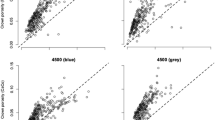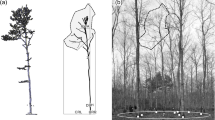Abstract
This study estimates the structure of a forest stand using high-resolution data from digitized aerial photography. The study area was conducted on the fifteen plots with the size of 20 m × 20 m or 15 m × 15 m taken as samples of sugi (Cryptomeria japonica D. Don) stands. The stand factor was investigated based on its relation with the digitalized number (DN) on the black and white aerial ortho photos (scale 1:5,000, taken in 1995). We analyzed various stand structure factors and the distribution of DN from the image data using the Weibull function, which comforms well to every shape of distributions. Using the Weibull distribution, a significant negative correlation was observed between the quantity of stand factors (Mean DBH and the stand volume) and the distribution parameterc of DN. A significant positive correlation was also observed between the distribution parameterc of the stand factor (DBH, height and volume) and the distribution parameterc of DN.
Similar content being viewed by others
Literature cited
Abe, N. (1980) Studies on the management ofAbies sachalinensis Mast. planted forest (II): Yield table ofAbies sachalinensis in Hokkaido Prefectural forest. Bull. Hokkaido Forest Exp. Stn. 18: 71–93. (in Japanese with English summary)
Bailey, R.L. (1973) Quantifying diameter distributions with the Weibull functon. For. Soc. 19: 97–104.
Befort, W.A., Kessler, B.L., and Anderson, H.N. (1981) Stand den sity estimation on panoramic transparencies. Photgr. Eng. Remote Sens. 10: 1477–1481.
Cohen, W.B. and Spies, T.A. (1990a) Remote sensing of canopy structure in the Pacific Northwest. Northwest Environ. J. 6: 415–418.
Cohen, W. B. and Spies, T. A. (1990b) Semivariograms of digital imagery for analysis of conifer canopy structure. Remote Sens. Environ. 34: 167–178.
Cohen, W.B. and Spies, T.A. (1992) Estimating structural attributes of Douglas-Fir/Western Hemlock forest stand from Landsat and SPOT imagery. Remote Sens. Environ. 46: 1–17.
Kinashi, K. (1978) The study of forest inventory. 269pp, Noorin Shuppan Co., Ltd., Tokyo.(in Japanese)
Kinashi, K., Chou, M., and Sue, K. (1967) The study of estimating stand volume by measuring aerial photographic concentration (IV): the concentration wave shape and the stand volume. The Trans 78th Ann Meet. Jpn. For. Soc.: 54–56. (in Japanese)
Lillesand, T. M. and Kiefer, R. W. (1994) Remote sensing and image interpretation: Third edition. 200pp, John Wiley & Sons, Inc., New York, Chichester, Brisbane, Toronto, Singapore.
Nishizawa, M., Kinashi, K., Kakihara, M., and Chou, M. (1976) The study of growth model for stand’s simulation(III); The estimation of d.b.h. probability distribution by Weibull parameter. Trans. Jpn. For. Soc. 87:87–88. (in Japanese)
Osumi, S. (1961) On the frequency distribution of d.b.h. in stand. Bull. Kyoto Pref. Univ. For. 5: 9–17. (in Japanese with English summary)
St-Onge, B. A. and Cavayas, F. (1995) Estimating forest stand structure from high resolution imagery using the directional variogram. Int. J. Remote Sens. 11: 1999–2021.
Author information
Authors and Affiliations
About this article
Cite this article
Kamioka, H., Abe, N. Estimating stand structure using digitalized aerial photography. J For Res 4, 75–78 (1999). https://doi.org/10.1007/BF02762229
Accepted:
Issue Date:
DOI: https://doi.org/10.1007/BF02762229




